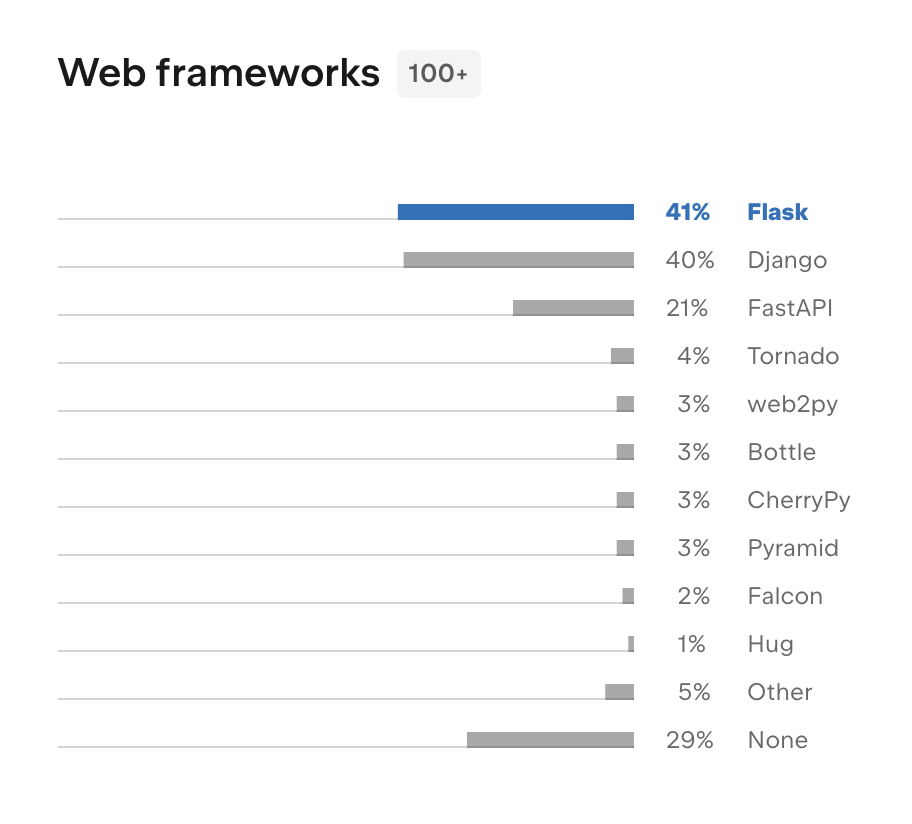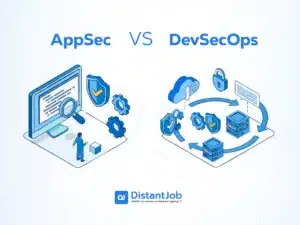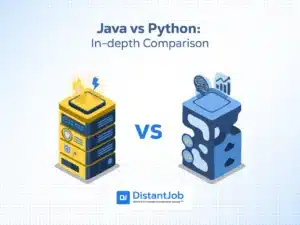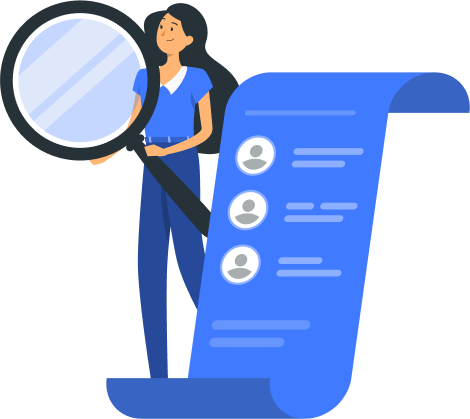Python remains a relevant programming language in 2025, as it is used in almost every field, including web development, data science, machine learning, and automation. The reason it continues to be so relevant is its flexibility and the strong frameworks that are being developed around it. Choosing the right framework is critical for companies who want to keep up with trends such as AI, microservices, cloud-native deployment, and better performance.
The simplicity of the language and the rich libraries available, such as Pandas, NumPy and TensorFlow, have made it the go-to language for data science and AI.
However, despite its popularity, developers still need to tackle a range of challenges, from managing web application scalability to navigating the complexities of data analysis and asynchronous programming.
Here’s where Python frameworks come into play as they provide invaluable assistance, allowing developers to streamline the development process, enhance code quality, and more.
Let’s go over the 11 most popular Python frameworks, exploring their optimal uses and standout features.
This table covers the best Python frameworks in 2025, with both the tried-and-tested favorites as well as the up-and-coming contenders. We explore their main features and best use cases, helping you decide which one is the better choice for your projects.
| Framework | What It’s For | Why Choose It | Perfect When You Need | 2025 Focus |
|---|---|---|---|---|
| Django | Building websites & web apps | Everything included out of the box | Large, secure business applications | Better performance, AI features, breaking apps into smaller pieces |
| FastAPI | Creating fast web services | Lightning-fast API responses | Real-time apps that need instant data | AI/ML integration, handling many requests at once |
| Flask | Simple web apps & services | Lightweight, you control everything | Quick prototypes or small, focused services | Deploying ML models, API-first design |
| TensorFlow | AI & machine learning | Powers massive AI systems | Large-scale AI projects in production | Scaling up, high performance, AI-driven apps |
| PyTorch | AI research & development | Flexible, great for experimenting | Cutting-edge AI research and development | Moving from research to real products |
| Scikit-learn | Traditional machine learning | Easy to learn, covers the basics | Data analysis and classic ML tasks | User-friendly ML, foundational learning |
| Hugging Face | Language AI | Ready-to-use language models | Building chatbots, text analysis, AI assistants | Responsible AI, collaborative AI development |
| XGBoost | Predictive analytics | Extremely accurate predictions | Competition-winning models, business forecasting | Combining different models, automated optimization |
| Dask | Big data processing | Handles datasets too big for memory | Processing massive amounts of data | Parallel computing, big data analytics |
| Selenium | Web testing automation | Tests websites like a human would | Cross-browser testing, UI automation | AI-powered testing, cloud scaling, CI/CD integration |
| PyTest | Code testing | Flexible testing for any Python code | Testing everything from simple functions to complex systems | Extensive plugins, versatile testing approaches |
Top Python Frameworks for Web Development & APIs
Web development in 2025 has changed quite a bit. We’ve seen AI being introduced to many apps, moved to microservices, and API-first environments. We can develop MVPs at a much faster pace. Python is not just up-to-date with these trends but is ahead of the game. One of the reasons Python is strong in web development is that it offers an advantage in the AI-First web. Here are the top 3 Python frameworks for web development:
1. Django
Django is still a full-stack framework with a multitude of features for fast development. These features include an admin panel, ORM, authentication, and built-in security. Founded by the principle of DRY, “Don’t Repeat Yourself,” Django aims to simplify the creation of complex, database-driven websites.
Django is structured around the Model-View-Template (MVT) pattern, a variant of the traditional Model-View-Controller (MVC) architecture.
In MVT, the model defines the data structure using Django’s Object-Relational Mapping (ORM) layer, allowing developers to interact with SQL databases through Python code rather than writing raw SQL queries. This design facilitates a clean separation of concerns, with models managing the database, views handling the business logic, and templates dealing with presentation.
Often described as an “all-inclusive” framework, Django provides almost everything a developer needs to build a web application without requiring external libraries for basic functionalities. This includes an ORM for database operations, authentication mechanism, URL routing, admin panel and more.
Here’s a simple example of how Django’s ORM can be used to define a database schema and perform operations:
from django.db import models
class User(models.Model):
username = models.CharField(max_length=100)
email = models.EmailField()
# Creating a new user would be as simple as:
# User.objects.create(username='john', email='[email protected]')Django also places a strong emphasis on security, offering built-in protections against many common vulnerabilities, such as SQL injection, cross-site scripting (XSS), cross-site request forgery (CSRF), and clickjacking.
Use Cases:
- E-commerce Platforms
- Content Management Systems (CMS)
- Social Media Sites
Django’s advantages include millions of monthly PyPI downloads, extensive documentation, security by default, and its ability to facilitate rapid development for complex systems.
2. FastAPI
FastAPI has rapidly emerged as a leading framework specifically designed for building high-performance APIs. FastAPI is ideally suited for real-time mobile backends, real-time chat or update applications, data-intensive APIs, scalable startup solutions, and modern asynchronous web applications, particularly those requiring seamless machine learning integration.
This is one of the fastest frameworks for Python, thanks to its Starlette framework foundation for handling asynchronous requests and its Pydanic library for data validation. This combination not only makes FastAPI quick but also efficient in terms of developer time and server resources.
Additionally, FastAPI is designed to be easy to use, with intuitive syntax that makes developing robust APIs straightforward. Its dependency on Python 3.6+ type hints ensures that the code is clean and easy to understand.
Another major advantage of FastAPI is that it automatically generates interactive API documentation using Swagger UI and ReDoc, making it easy for developers to test and document their APIs. This auto-generated documentation is a significant advantage for maintaining up-to-date API docs.
By simply running the FastAPI app, developers get automatic API documentation at / docs (Swagger UI) and / redoc (ReDoc) endpoints without writing any extra documentation code.
Use Cases:
- RESTful APIs.
- Creating APIs for data science and machine learning models
- Developing real-time web applications using WebSockets.
FastAPI’s advantages include rapid development with minimal code, built-in data validation, widespread adoption with millions of downloads, and its suitability for real-time applications. Its ability to fully utilize multi-core CPUs through asynchronous programming contributes to its excellent performance.
3. Flask
Flask was the #1 Python framework, with the highest percentage of use among developers in 2024.
In 2025, Flask is expected to maintain its status as a preferred micro web framework, particularly for REST API development and ML model deployment.

Considered a microframework, Flask comes with basic functionality, but what makes it unique is that it allows easy expansion, allowing you to join libraries with each other easily.
Flask provides essential tools and features for web development, such as URL routing, template, rendering and HTTP request handling, while allowing developers the flexibility to add additional functionality through its ecosystem of extensions.
Unlike some larger frameworks, Flask does not impose a specific structure or set of dependencies on developers, allowing for greater freedom and customization in how applications are built.
For example, if you need an ORM (Object-Relational Mapping) for database interactions, you can choose SQLAlchemy or Django ORM and integrate it with Flask using Flask-SQLAlchemy. Similarly, for form validation, you could use WTForms. This approach lets developers tailor their stack to their precise requirements.
Use Cases:
- API Development
- Microservices
- Prototyping
Top Python Frameworks for Data Science & Machine Learning
Python’s preeminence in Data Science and AI is projected to expand significantly in 2025, propelled by continuous advancements and the development of new tools.
4. TensorFlow
TensorFlow is a very powerful machine-learning and deep-learning open-source library, optimized for models that are being sent to production. It has top-notch performance and scaling capabilities, as well as great support for hardware accelerators like TPUs and GPUs. Since
TensorFlow is a considered low-level library, it provides considerable control over your model architecture and training steps.
Its primary use cases involve large-scale deep learning applications, predictive analytics, real-time object detection, and the development of autonomous decision-making systems.
Its advantages include robust scalability for distributed computing and large datasets, along with an extensive suite of tools tailored for production deployment, such as TensorFlow Serving and TensorFlow Lite. However, working with its low-level APIs can present a moderate to steeper learning curve for developers.
5. PyTorch
PyTorch is one of the most popular frameworks (especially for deep learning and researching models) because it provides dynamic computation graphs and easier debugging. It provides substantial control over model architecture and training, offering exceptional flexibility. Its intuitive and Pythonic interface, coupled with strong GPU acceleration support, makes it a preferred choice for many.
PyTorch is mostly used for state-of-the-art deep learning projects and basic research and new algorithms. For example, Facebook uses PyTorch to run their advanced features including automatic image tagging and selecting which news item you should see in your feed.
Additionally, PyTorch offers robust support for deploying models in production environments, including seamless integration with ONNX.
Its advantages include eager execution, the ability to swiftly transition from development to graph mode for high performance in C++ runtimes, asynchronous execution, and an end-to-end workflow facilitating mobile deployment. A potential drawback is that its dynamic computation can sometimes result in slower execution speeds compared to frameworks utilizing static graphs.
6. Scikit-learn
Scikit-learn is a goto machine learning library for your more classical machine learning operations (e.g., classification, regression, clustering) because of its clean API, huge variety of built-in models, and strong feature engineering support. The documentation of this framework has been known to be one of the clearest and easiest to understand.
Some of the best things that Sciki-learn does are: classification, regression, clustering, model selection, dimensionality reduction, data preprocessing, and feature engineering. When it comes to small/medium datasets and classical machine learning models, Scikit-learn is your best tool.
Advantages include a rich collection of classical ML algorithms, clear documentation, and seamless integration with other Python data science libraries. However, it is not specifically designed for deep learning tasks and lacks built-in GPU acceleration support, making other frameworks more suitable for complex neural networks or computationally intensive GPU operations.
7. Hugging Face Transformers
Hugging Face Transformers is a game-changer collection of pretrained transformer models that have shifted the landscape in the NLP world. This library makes it easier to perform many NLP tasks.
The framework’s use cases extend beyond traditional NLP to encompass large language model (LLM) tasks, multimodal intelligence (integrating text and vision), federated learning, real-time edge AI, and explainable AI (XAI).
Its advantages include seamless integration with PyTorch, JIT compilation, and TorchScript, enabling collaborative AI without compromising privacy. Hugging Face Transformers represents a paradigm shift in AI, moving beyond conventional NLP to embrace multimodal AI, ethical considerations, and distributed learning. Its emphasis on pre-trained models and ease of use accelerates the development of sophisticated AI applications, making advanced NLP and LLMs accessible to a broader developer base.
Use Cases:
- generative AI
- advanced language understanding
8. XGBoost
XGBoost is known as one of the highest performing and accurate machine learning libraries in the world for many different projects. For complex relationships, data imbalance, and feature engineering ( 9.4), this library rocks!
While generally highly efficient, XGBoost’s exact algorithm can sometimes be slower than LightGBM in specific scenarios due to its exhaustive search for optimal splits. Overfitting remains a potential risk with highly complex models, necessitating the use of techniques like cross-validation and early stopping.
Use cases:
- predictive modeling, especially with tabular data
- various classification
- regression tasks.
9. Dask
Dask is a general library for parallelized computation on a cluster or a multi-core machine built on top of the NumPy, Pandas, and Scikit-learn Python data-science libraries.
Its core strength lies in enabling parallelized computation across clusters or multi-core machines. Dask provides asynchronous methods and sophisticated client and future management capabilities, essential for distributed workflows.
Dask offers functionality comparable to Apache Spark, indicating its significant role in scalable data workflows. Its main advantage is a substantial increase in performance when handling large datasets, coupled with seamless integration with existing Python data science libraries.
While powerful, adopting Dask can present a learning curve for those new to distributed computing concepts.
Use cases:
- Handling exceptionally large datasets that exceed the memory capacity of a single machine.
- It facilitates the creation of distributed datasets where data segments reside on different machines but can be processed as a unified dataset from the user’s perspective.
Top Python Frameworks for Automation & Testing
Python is going to continue to be the master programming language of the testing/automation world by 2025. That’s because it is extremely flexible, easy to pick up for beginners and surprisingly strong for advanced users. The testing field itself is seeing quite a lot of advancements, including AI plugins, cloud scaling, better cross-browser support, and improved integration with CI/CD.
10. Selenium
Selenium is an open-source project that automates browser activities (e.g., clicking on a button). It supports popular browsers, such as Chrome, Firefox, and Edge, and includes language bindings for several languages, with Python as its top option. Selenium works well with CICD tools and other frameworks like PyTest.
Now I’m getting ahead of myself. Virtualization is a technology that gained popularity more than two decades ago. It allows you to create software-based representations of servers, enabling you to conveniently run an operating system within a window on your existing computer screen.
Alternatively, you can use multiple virtual machines on a single server to efficiently isolate different users who don’t require the full resources of a server. This concept is analogous to the philosophy behind our VM server. Each virtual machine (VM) functions as a fully independent entity, allowing you to operate as if you are the sole user of that server.
Selenium’s advantages include broad language support, a well-established ecosystem, extensive community support, and robust cross-browser compatibility. However, it can present a relatively high learning curve and integration complexity for new users.
Use Cases:
- web testing
- building browser-based regression automation suites and executing tests across diverse environments
11. PyTest: The Versatile and Extensible Testing Framework
PyTest is considered easy to use for testers while still very powerful, which is why it’s the most popular choice. Its three strongest features are:
- its use of fixtures to perform setup and teardown of the test;
- its ability to create parameterized tests to reuse the same test for many different options;
- It’s a very strong plugin system to support additional tools.
Advantages include its ease of learning, powerful features, and adaptability due to its fixtures and plugin architecture, all supported by a strong community.
Unlike some other tools, PyTest does not require additional downloads, as it is a framework that integrates directly with Python. PyTest’s strength lies in its balanced approach to simplicity and extensibility. Its modular design, driven by fixtures and a rich plugin ecosystem, allows it to adapt to a wide array of testing scenarios, from basic unit tests to intricate integration flows, solidifying its position as a preferred choice for developers in 2025
Use Cases: PyTest is widely used for creating both unit tests and more complex functional tests. It can be effectively paired with libraries like Requests for comprehensive API testing
Conclusion
When choosing a Python framework, the decision comes down to matching your specific needs with the right tool. Use Django for large, complex applications; Flask for smaller, customizable projects; and FastAPI for high-performance APIs with AI integration.
Consider your team’s experience level, performance requirements, and future technology trends. Choose specialized tools like TensorFlow for production deep learning, PyTorch for research, and Scikit-learn for standard machine learning. The best framework is the one that fits your actual requirements, not necessarily the most popular one.
The key is being honest about your project’s requirements and your team’s capabilities, then choosing the framework that best fits both rather than picking the most popular or newest option.
It’s not a matter of becoming an expert in all of them but learning how to choose the one that aligns with your project’s requirements.
Also, keep in mind that the best way to create successful Python applications goes beyond the right toolkit. It starts by building the right team. If you’re looking for an expert Python developer, we can help you.
At DistantJob, being an IT staffing agency for over a decade, we’ve carefully designed a recruitment process to match companies with talented Python developers successfully. Want to know more? Let’s talk.
FAQ
A Python framework is a pre-established set of tools and features that provide a structured foundation for developing software applications using the Python programming language.
These frameworks offer standardized solutions for common development tasks, like handling web requests, managing database interactions, and structuring application code.
A library is a set of reusable code pieces that a developer can incorporate into their own code, choosing when to use them, while a framework sets the overall structure and flow of an application, inverting control by calling upon the developer’s code according to its pre-defined template or operations.
Flask is a great choice for beginners due to its simplicity, minimalistic and unopposed approach, allowing beginners to quickly understand and start creating web applications without being overwhelmed by too many components.





